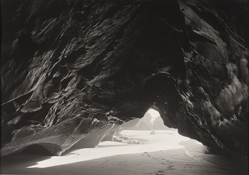Vaughn
Subscriber
All just to say, sometimes 13 or 14 stops of light is fun to play with.
Thirteen stops difference in this scene...possibly more as the meter only read down to 0. Just slight less than normal development (5x7/210mm lens), Carbon print, camera negative, straight print (no burning/dodging).
So what I am saying is Zone -I would be the darkest in the cave roof that are pure black (and smooth). Some of that black area corresponds to no silver on the negative and are smooth. Some areas are equally black but correspond to thin areas of the negative that still have image within them. The detail in these areas read as equally black sharp relief within the areas of smooth black. This detail is seen as light reflects off the relief when viewing the print...not by differences in tonalities
PS...I could have used another stop equivilent of exposure or so for the top of the image...but it still looks like a cave.
Thirteen stops difference in this scene...possibly more as the meter only read down to 0. Just slight less than normal development (5x7/210mm lens), Carbon print, camera negative, straight print (no burning/dodging).
So what I am saying is Zone -I would be the darkest in the cave roof that are pure black (and smooth). Some of that black area corresponds to no silver on the negative and are smooth. Some areas are equally black but correspond to thin areas of the negative that still have image within them. The detail in these areas read as equally black sharp relief within the areas of smooth black. This detail is seen as light reflects off the relief when viewing the print...not by differences in tonalities
PS...I could have used another stop equivilent of exposure or so for the top of the image...but it still looks like a cave.
Attachments
Last edited:








